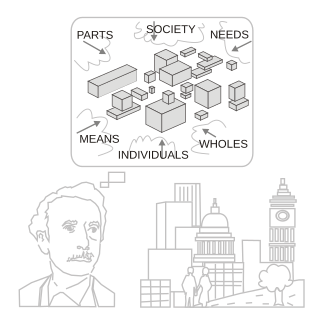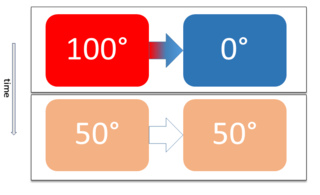Related Research Articles

In statistical mechanics and mathematics, a Boltzmann distribution is a probability distribution or probability measure that gives the probability that a system will be in a certain state as a function of that state's energy and the temperature of the system. The distribution is expressed in the form:

Bottom–up and top–down are both strategies of information processing and ordering knowledge, used in a variety of fields including software, humanistic and scientific theories, and management and organization. In practice they can be seen as a style of thinking, teaching, or leadership.

The second law of thermodynamics is a physical law based on universal empirical observation concerning heat and energy interconversions. A simple statement of the law is that heat always flows spontaneously from hotter to colder regions of matter. Another statement is: "Not all heat can be converted into work in a cyclic process."

The first law of thermodynamics is a formulation of the law of conservation of energy in the context of thermodynamic processes. The law distinguishes two principal forms of energy transfer, heat and thermodynamic work, that modify a thermodynamic system containing a constant amount of matter. The law also defines the internal energy of a system, an extensive property for taking account of the balance of heat and work in the system. Energy cannot be created or destroyed, but it can be transformed from one form to another. In an isolated system the sum of all forms of energy is constant.

Positive feedback is a process that occurs in a feedback loop which exacerbates the effects of a small disturbance. That is, the effects of a perturbation on a system include an increase in the magnitude of the perturbation. That is, A produces more of B which in turn produces more of A. In contrast, a system in which the results of a change act to reduce or counteract it has negative feedback. Both concepts play an important role in science and engineering, including biology, chemistry, and cybernetics.
In economics, economic equilibrium is a situation in which economic forces such as supply and demand are balanced and in the absence of external influences the values of economic variables will not change. For example, in the standard text perfect competition, equilibrium occurs at the point at which quantity demanded and quantity supplied are equal.

Systems thinking is a way of making sense of the complexity of the world by looking at it in terms of wholes and relationships rather than by splitting it down into its parts. It has been used as a way of exploring and developing effective action in complex contexts, enabling systems change. Systems thinking draws on and contributes to systems theory and the system sciences.
Thermodynamic equilibrium is an axiomatic concept of thermodynamics. It is an internal state of a single thermodynamic system, or a relation between several thermodynamic systems connected by more or less permeable or impermeable walls. In thermodynamic equilibrium, there are no net macroscopic flows of matter nor of energy within a system or between systems. In a system that is in its own state of internal thermodynamic equilibrium, no macroscopic change occurs.

Structural functionalism, or simply functionalism, is "a framework for building theory that sees society as a complex system whose parts work together to promote solidarity and stability".
The heat death of the universe is a hypothesis on the ultimate fate of the universe, which suggests the universe will evolve to a state of no thermodynamic free energy, and will therefore be unable to sustain processes that increase entropy. Heat death does not imply any particular absolute temperature; it only requires that temperature differences or other processes may no longer be exploited to perform work. In the language of physics, this is when the universe reaches thermodynamic equilibrium.

Two physical systems are in thermal equilibrium if there is no net flow of thermal energy between them when they are connected by a path permeable to heat. Thermal equilibrium obeys the zeroth law of thermodynamics. A system is said to be in thermal equilibrium with itself if the temperature within the system is spatially uniform and temporally constant.
The AGIL paradigm is a sociological scheme created by American sociologist Talcott Parsons in the 1950s. It is a systematic depiction of certain societal functions, which every society must meet to be able to maintain stable social life. The AGIL paradigm is part of Parsons's larger action theory, outlined in his notable book The Structure of Social Action, in The Social System and in later works, which aims to construct a unified map of all action systems, and ultimately "living systems". Indeed, the actual AGIL system only appeared in its first elaborate form in 1956, and Parsons extended the system in various layers of complexity during the rest of his intellectual life. Towards the end of his life, he added a new dimension to the action system, which he called the paradigm of the human condition; within that paradigm, the action system occupied the integral dimension.
Synergetics is an interdisciplinary science explaining the formation and self-organization of patterns and structures in open systems far from thermodynamic equilibrium. It is founded by Hermann Haken, inspired by the laser theory. Haken's interpretation of the laser principles as self-organization of non-equilibrium systems paved the way at the end of the 1960s to the development of synergetics. One of his successful popular books is Erfolgsgeheimnisse der Natur, translated into English as The Science of Structure: Synergetics.

Foundations of Economic Analysis is a book by Paul A. Samuelson published in 1947 by Harvard University Press. It is based on Samuelson's 1941 doctoral dissertation at Harvard University. The book sought to demonstrate a common mathematical structure underlying multiple branches of economics from two basic principles: maximizing behavior of agents and stability of equilibrium as to economic systems. Among other contributions, it advanced the theory of index numbers and generalized welfare economics. It is especially known for definitively stating and formalizing qualitative and quantitative versions of the "comparative statics" method for calculating how a change in any parameter affects an economic system. One of its key insights about comparative statics, called the correspondence principle, states that stability of equilibrium implies testable predictions about how the equilibrium changes when parameters are changed.

A system is a group of interacting or interrelated elements that act according to a set of rules to form a unified whole. A system, surrounded and influenced by its environment, is described by its boundaries, structure and purpose and is expressed in its functioning. Systems are the subjects of study of systems theory and other systems sciences.
A glossary of terms relating to systems theory.
In system theory, "differentiation" is the increase of subsystems in a modern society to increase the complexity of a society. Each subsystem can make different connections with other subsystems, and this leads to more variation within the system in order to respond to variation in the environment.

Temperature is a physical quantity that quantitatively expresses the attribute of hotness or coldness. Temperature is measured with a thermometer. It reflects the average kinetic energy of the vibrating and colliding atoms making up a substance.
The environmental sustainability problem has proven difficult to solve. The modern environmental movement has attempted to solve the problem in a large variety of ways. But little progress has been made, as shown by severe ecological footprint overshoot and lack of sufficient progress on the climate change problem. Something within the human system is preventing change to a sustainable mode of behavior. That system trait is systemic change resistance. Change resistance is also known as organizational resistance, barriers to change, or policy resistance.
A thermodynamic operation is an externally imposed manipulation that affects a thermodynamic system. The change can be either in the connection or wall between a thermodynamic system and its surroundings, or in the value of some variable in the surroundings that is in contact with a wall of the system that allows transfer of the extensive quantity belonging that variable. It is assumed in thermodynamics that the operation is conducted in ignorance of any pertinent microscopic information.
References
- ↑ Davis & Newstrom (1985). Organizational behaviour. ISBN 978-0-07-015508-4.
- Gilboa, Itzhak & Matsui, Akihiko, 1991. "Social Stability and Equilibrium", Econometrica , Econometric Society, vol. 59(3), pages 859–67, May.